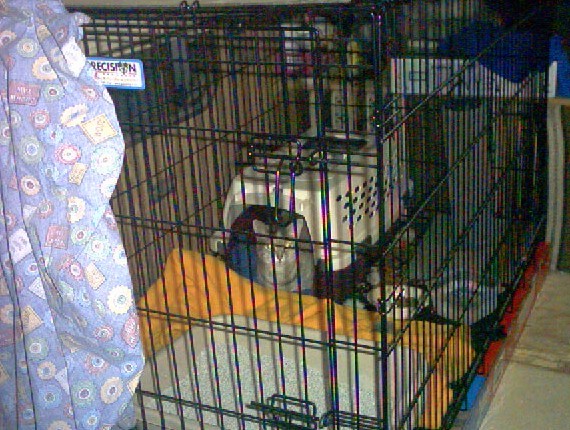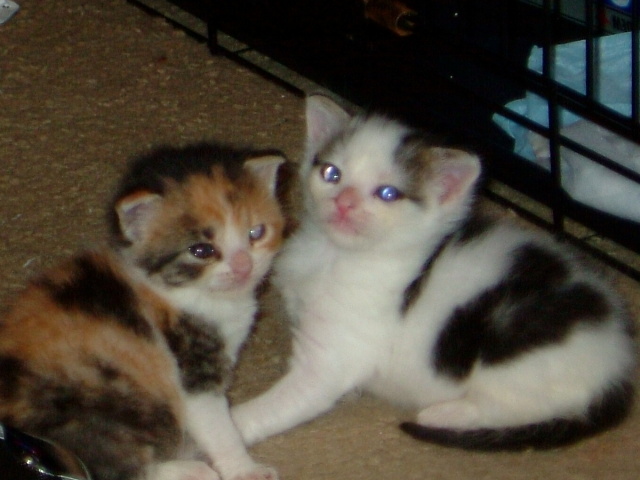QuestionHi Carol,
I love having a cat expert at my finger tips. I have a busy house with three noisy children. I have adopted a shy 6yr female from a breeder (now fixed). She has not turned out to be the family pet we hoped. She hides all day, and is very food driven. So, I adopted a male 5yr who is very social and friendly. He is looking for her all the time and wants to "play". She growls and hisses, but no big fights. I know of another very social female 2yrs and i am thinking about getting her so my two social cats are happy, and my shy cat is left alone. Any advice?
thanks,
Denise
AnswerDenise,
My name is Ali and I'll try to give you a few hints that will hopefully get things going back in the right direction for this kitty. I'm guessing that your question has come my way via the question pool. Ultimately I think that an examination by a holistic vet would be a good start to rule out any potential health issues that may not have been disclosed by the breeder or that may not have been present in initial health exam. It's important that you realize that not all breeders house their breeding queens and studs in a home environment. Based on your description of this little girl's behavior I'm inclined to think that she has spent the majority of her life in a cage within a cattery or at best in a small room with minimal human contact. The fact that your house is busy is likely quite anxiety provoking for this girl because she may not be used to much human activity or interaction going on with and around her. The troubles that you describe in regards to the more social male cat and the fact that he seems determined to bug this shy girl could be an indicator that the reason she was placed for adoption is because she wasn't coping well with the stressful breeding environment that cats housed in a cattery are exposed to. In fact, the environment in a breeding cattery is not exactly cat friendly. I would guess that the "play" behavior you describe on the male cat's part is actually dominance and the shy girl is reacting defensively because she's scared and has most likely not been properly socialized which means that most situations are new to her.
At this time I'm not sure that bringing another cat into the house so soon is such a good idea. Ultimately getting the cats who already live with you to the point where they feel comfortable with one another and have begun to have a positive relationship with one another is important prior to adding anyone else to the household. There is hope to have the 6 year old girl and the 5 year old boy be friends yet, it will take a bit of time, commitment and patience as well as following a specific "program" to build confidence and socialize the two cats. At this point I would recommend that you hold off on introducing any other cats to the household and concentrate on getting the current resident cats feeling happy, safe and comfortable with one another so that they can be a family and co-exist happily with each other.
Cats are naturally quite territorial and if proper introductions haven't been made it's quite possible that your shy girl is simply intimidated, fearful and having trouble coping with the "in your face" approach of the male cat. If the male hasn't been neutered or has only recently been neutered (it takes awhile for sex hormones to drop off in the blood), his brain may well be hard wired and he may well be hoping to mate with this gal, if she was recently spayed she may still have the smell of an unspayed cat as far as a male cat is concerned because it takes some time for estrogen levels to drop and pheromones to change.
If this female cat has lived in an institutional environment for most or all of her life then it's quite possible that everything in a home environment is foreign to her. In terms of instincts it's quite normal and natural for people and animals of any kind to be anxious or fearful in completely new environments. In a cat whose been somewhat institutionalized I would guess that a home environment holds many new experiences from schedule changes to noise levels. Try to imagine being in a world where everyone is a giant, there's a lot of noise and these giants keep coming towards you and touch you. In the case of an institutionalized kitty she wouldn't necessarily understand who you are or why everything in her world has changed. If any person was placed in the same situation I would imagine that anyone would be anxious and fearful, so a little patience and understanding is going to go a long way towards bringing this girl around.
I generally recommend that any new cats coming into a household with cats already in residence be isolated for a period of 2-3 weeks. The isolation period serves a couple of different purposes - it allows for a quarantine period so that any viral/bacterial infections don't spread throughout the household and gives the vet a good opportunity to assess the health and condition of the new cats. In cases like this the isolation period works well for another reason - it gives a new/fearful kitty time to get used to the sights, sounds, smells and general household routines. In this case my recommendation would be to provide the new girl with a quiet, dimly lit room and provide access to all of the usual kitty necessities (food, water, litter box, soft, comfy place to sleep, a few toys, quiet attention and complete supervision of all children interacting with the cat to avoid injury to the cat or children). It's very important that you and other members of the household don't equate isolation with ignoring this cat because ignoring this cat isn't going to be helpful in terms of allowing her to become calmer and accustomed to everyone in the household without the added stress of dealing with another cat that she isn't familiar with.
I do think that this girl would benefit from the use of a homeopathic remedy called Bach's Rescue Remedy which is a blend of flower essences designed to calm and reassure. Rescue Remedy is a very safe remedy and is used fairly frequently by vets and pet guardians worldwide to help ease the stress related to anything from traumatic injury to the loss of a family member. This remedy isn't toxic and it shouldn't hurt the children if they do manage to get into it. I don't recommend that you administer the Rescue Remedy directly into the cat's mouth because it is preserved in a solution of grape alcohol that cats normally find quite offensive. You can usually find Rescue Remedy in natural health/health food stores and it's usually priced at around 15$ CAN or so. Given the fairly high level of this little girl's anxiety I would suggest that you try out a dose of around 9 drops of Rescue Remedy to be added to her fresh water every morning. You should start to see a fairly obvious difference in this little one's behavior within about 2-3 days. Keep in mind that things may progress gradually, but I do think with lots of love, patience, persistence, time, proper care, attention and a little help from a holistic vet things should turn around. A holistic vet is trained in conventional medicine as well as alternative therapies like acupuncture, massage or homeopathy. I have heard great things about acupuncture and massage as tools for helping calm cats and keep them healthy. I have personally used Rescue Remedy numerous times to help abused and abandoned cats regain their former happy, trusting natures. Based on my experience Rescue Remedy is quite effective when it comes to settling down a fearful/anxious cat.
The fact that you have children is another unique challenge. It's very important that the children understand that this cat is afraid and needs to be handled quietly, gently and with extra loving care. Children should always be supervised when interacting with pets of any kind so that nobody is accidentally injured as a result of improper handling. If your children are interested in being helpful they can help this kitty progress very well. Obviously very young children won't be able to follow the suggestions that I'm going to make without the help of an older child or an adult. You may want to try having one child at a time go into the room where this kitty is being temporarily quarantined and sit down quietly for a fairly short period of time, say around 5-10 minutes. Short, frequent visits by as many family members without the demand of interaction or attention should help to build this cat's confidence.
The nice thing about building confidence in a cat is that if it's done correctly you will most likely see steady improvement over a fairly short period of time. It's important that everyone in the family that is trying to help resocialize this kitty follows a specific routine when going into her room. At this point I wouldn't recommend that anyone makes a point of trying to handle her. The best thing to do is to come into the room, don't speak, don't make eye contact and don't touch this kitty unless she initiates it. Bring a book, play a handheld video game, do a crossword puzzle, anything that takes the direct focus off of the cat while a person is in the room and doesn't make much noise will work well. I did notice that you mentioned the fact that your fearful/anxious kitty is food motivated. Food is a great tool for this kind of situation, in fact food is a great tool for positive reinforcement of any behavior which includes any tricks that you may try to teach this kitty later on when she's more confident.
I normally use cooked chicken, salmon, or tuna for these situations. Some cats will enjoy sardines, canned tuna, canned salmon, so essentially you will have to find out what motivates this cat. Once the kitty is spending time coming out of hiding consistently with one or more members of the family it's a good idea to bring special treats into the room to reward positive behavior. Food rewards have to be consistent to be effective so I would recommend that you use the 3 second rule to explain when and how to reward this kitty to your family members. What I mean by the three second rule is that any positive behavior should be rewarded within 3 seconds or less of it happening, that way the cat understands the connection between the food reward and the positive behavior.
In a situation like this the best resources beyond food and being quietly present are going to be time, patience and persistence. Because of the fact that cats are naturally curious most will find it impossible not to eventually come out of hiding to find out what the quiet human is doing. The cat will come to a point where she will begin to rub the side of her face against furniture in the room or even a family member who is in the room with her. When it comes to working with fearful cats that spend much of their time hiding I have to admit that there have been moments where I've wanted to jump up and dance around the room when a cat finally came to me and began rubbing his/her face against me, but allowing yourself to do so may set this kitty back so it's best to keep the joyful dance to yourself and ignore her as much as possible. When a cat rubs his/her face against an object or person he/she is marking the object or person with pheromones and his/her own unique scent. A cat bumping his/her head against you is a sign of acceptance. It will be very important to remember that once your cat is comfortable you will (at least initially) want to pet her from below her body and head, scratching her chin or the side of her face works well to build her confidence and avoid creating a fearful response.
Building this kitty's confidence is likely to be a whole family affair, but again, things need to be done slowly, quietly and patiently for the first while. Once this kitty is a bit more confident your children can participate in building her confidence by using toys like a kitty tease to gently play with her, although I would recommend that you watch the children carefully to ensure that things aren't getting out of hand and the children aren't coming on too strong. Once your little girl kitty is feeling more comfortable with her surroundings and the people in her family you can certainly allow face to face contact between the 6 year old girl and the 5 year old boy. If the male hasn't been sterilized he may well try to mate with the sterilized female cat which would cause quite a stir, so it's important to have the boy neutered as soon as possible if he hasn't already been taken care of in that respect.

 albinism
Question
Cat
Hello! I was wondering if you could
albinism
Question
Cat
Hello! I was wondering if you could
 Kitten introduction
Question
the brothers
I recently (yesterday) int
Kitten introduction
Question
the brothers
I recently (yesterday) int
 vacation house and taking cat
Questionour permanent home is on a 3 acre semi wooded p
vacation house and taking cat
Questionour permanent home is on a 3 acre semi wooded p
 18 year old cat has blood clots in urine
Question
Tucker
My 18 year old male neutered cat is hyp
18 year old cat has blood clots in urine
Question
Tucker
My 18 year old male neutered cat is hyp
 2 Ferals
Question
Sister and Brother at
Hello!
Im so glad I fo
2 Ferals
Question
Sister and Brother at
Hello!
Im so glad I fo